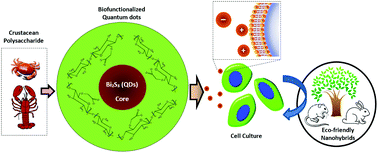Cytotoxicity investigation of luminescent nanohybrids based on chitosan and carboxymethyl chitosan conjugated with Bi2S3 quantum dots for biomedical applications
Abstract
Bioengineered hybrids are emerging as a new class of nanomaterials consisting of a biopolymer and inorganic semiconductors used in biomedical and environmental applications. The aim of the present work was to determine the cytocompatibility of novel water-soluble Bi2S3 quantum dots (QDs) functionalized with chitosan and O-carboxymethyl chitosan (CMC) as capping ligands using an eco-friendly aqueous process at room temperature. These hybrid nanocomposites were tested for cytocompatibility using a 3-(4,5-dimethylthiazol-2yl) 2,5-diphenyl tetrazolium bromide (MTT) cell proliferation assay with cultured human osteosarcoma cells (SAOS), human embryonic kidney cells (HEK293T cells) and a LIVE/DEAD® viability-cytotoxicity assay. The results of the in vitro assays demonstrated that the CMC and chitosan-based nanohybrids were not cytotoxic and exhibited suitable cell viability responses. However, despite the “safe by design” approach used in this research, we have proved that the impact of the size, surface charge and biofunctionalization of the nanohybrids on cytotoxicity was cell type-dependent due to complex mechanisms. Thus, these novel bionanocomposites offer promising prospects for potential biomedical and pharmaceutical applications as fluorescent nanoprobes.



 Please wait while we load your content...
Please wait while we load your content...